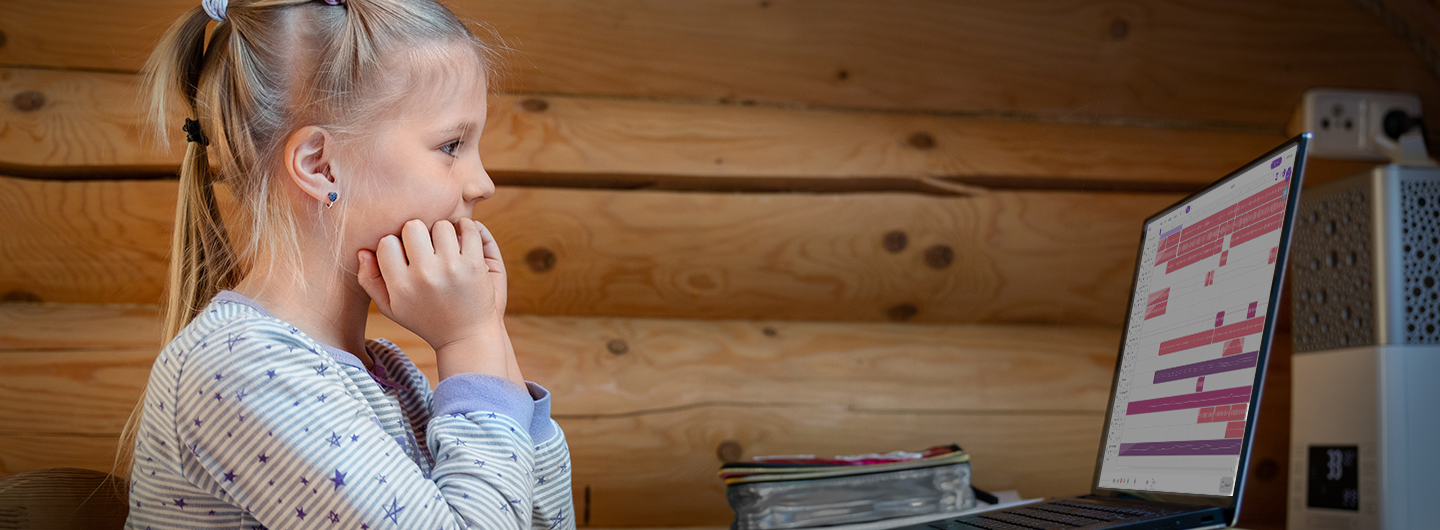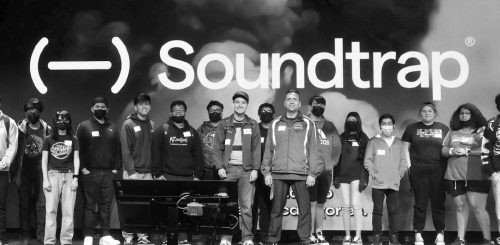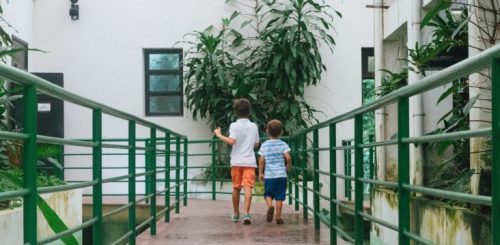
Students Can Start Home Recording Studios with Soundtrap for Education
September 23, 2022Music is a vital component of a balanced educational experience. By creating music, students have the opportunity to discover profound truths about themselves while learning more about society as a whole.
However, a fully-equipped musical classroom no longer requires an ensemble of instruments and pages of sheet music. Music education evolves, and technology advances. Today, music teachers only need the internet and the right Digital Audio Workstation (DAW) to deliver engaging lesson plans for students at every skill level.
The most impactful educators are open to new ideas and teaching methods. As technology transforms music education, more teachers are working with online audio production software that is accessible and encourages students to create songs of their own.
The Impact of Technology on Music Education
Today’s students are digital natives, so teachers must adapt to a tech-savvy world to effectively educate new generations. Educators that ignore or dismiss the utilization of technology miss an opportunity to engage their students in new and exciting ways.
Music Technology Allows Teachers to Accommodate Different Learning Styles
Since music and creativity flourish in a fluid environment, teachers must incorporate various teaching methods that serve different learning styles. As education progresses, the traditional learning model that centers around repetition and memorization is being replaced with hands-on lesson plans.
Traditional music education methods can cause frustration in students, decreasing their motivation to engage with learning materials. Today, students are absorbing information through methods that use visual, auditory, and kinesthetic learning styles in conjunction.
Moreover, technology in music education allows budding musicians, songwriters, and audio producers to learn the origin of music they enjoy making by hearing it in real time. Students can open their minds to different music styles, and teachers can incorporate the history of music types into their lesson plans. The advancement of technology gives students the ability to become more well-rounded in their music education without having to go out and purchase those instruments.
Cloud-Based Audio Production Software Enhances Accessibility
The use of technology in the classroom presents ample opportunities to enhance comprehension, collaboration, and engagement. However, educators are still in the process of discovering the best ways to leverage this technology for music education.
Luckily, once a luxury reserved for an elite few, at-home recording studios are now accessible to anyone with a mobile device or tablet. Today, students can access DAWs from an application and record music anywhere they go.
Music education continues to evolve as a direct result of technological advancements. Unlike in the past, teachers can give students assignments. Through educational DAW platforms, remote lesson plans can be completed on any personal device with an internet connection. Inside certain cloud-based DAW platforms, teachers can create student groups, assign goal-based projects, and even organize peer-review. This keeps assignments all in one secure platform that can be accessed anywhere.
It’s easier than ever for students to tap into their creative power when audio production platforms give them access to thousands of loops, sound effects, and instruments without requiring physical equipment. Meanwhile, cloud enablement ensures students can work from anywhere, whether that’s in the classroom, the library, or at home.
The Rise of At-Home Recording Studios
Advancements in computing technology and DAWs have played an integral role in audio production. As technology evolves, audio production software has become more accessible and user-friendly for both teachers and students. In a mere five years, at-home recording studios have proven their ability to rival professional recording studios.
The Early History of Recording Studios
Audio production technology traces back to inventors like Thomas Edison and Alexander Graham, who helped create technology for the phonograph industry in the 19th century. Building off these advancements, Otto KE Heineman established the world’s first recording studio, Okeh Records Studio, in 1918. In Heineman’s recording studio, musicians recorded tracks in real time and captured the audio using master discs.
Shortly after that, new technology allowed audio engineers to electronically mix audio tracks from microphones and amplifiers to create a single signal. At this point, record labels could record, produce, and market records for anyone to purchase.
By the 1950s, legendary recording studios made way for groundbreaking innovations in recording and music. During this time, famed producer Sam Phillips developed echo techniques. This led to the rise of of artists like Elvis Presley, Johnny Cash, Roy Orbison, and other notable names. When Capitol Records finished building the Capitol Tower in 1956, Michael Rettinger was the first to use state-of-the-art acoustic techniques to record artists, such as Frank Sinatra and Nat “King” Cole.
Fast forward to the 70s. Advancements in recording technology allowed the St. Paul Chamber Orchestra to create the first digital recordings suitable for commercial release. At this point, audio production began to resemble modern audio production. By the late 70s and 80s, affordable cassette tape technology allowed musicians and audio producers to record music at home.
At-Home Recording Studios in the Digital Era
Modern audio production methods appear nothing like their predecessors. In the digital age, musicians and audio producers can make magic with a laptop or smartphone. As a result, recording budgets are smaller than ever. However, mobile devices and cloud-based DAWs allow any musician to record, mix, and master music from home.
In the 2010s, CD sales came to a screeching halt as streaming platforms rose to prominence. Now, the entire music industry operates a new model. The new model prioritizes streams rather than record sales. As streaming has grown, social media platforms such as Youtube, TikTok, and Instagram allowed artists to cultivate a loyal fanbase.
When the COVID-19 pandemic began in 2020, the music industry experienced another critical transformation. Since fans could no longer attend in-person performances, they turned to virtual concerts and live streams to engage with their favorite artists. As music streaming services like Spotify begin to deliver live streaming experiences, the digital era presents limitless opportunities for anyone with music interests.
How At-Home Recording Studios Empower Students
Today’s audio production software allows anyone to access an at-home recording studio. The only thing they need is an internet-connected mobile device. Even elementary school students can use a laptop, smartphone, or tablet to create music with cloud-based DAWs like Soundtrap for Education.
Music teachers that adapt to society’s digitization and incorporate these tech tools into their curriculum provide students with the freedom to express themselves. Furthermore, cloud-based DAWs create an easy entry point into music creation for older students that haven’t participated in band or choir. Access to modern audio production software empowers students to take control of their musical education.
No Barrier to Learning
Digital music production tools mean students no longer need to master complex music theory before moving on to music composition. Even if students don’t know how to play chords on a guitar or piano, digital instruments allow them to work with pitch-perfect sound from the outset. From there, music teachers can guide them through the process of uploading these sounds to a digital platform. On the digital platform, they can create loops and build the foundation for a stellar song.
In the past, students couldn’t participate in music education unless they learned how to read sheet music and play instruments. However, enabling students to learn music through DAWs gives them access to hundreds of instruments, a way to learn through more than just memorization, and the ability to collaborate with their classmates from anywhere.
In traditional music education, schools allocate a significant portion of their financial resources into providing students with instruments. This investment makes cost a significant limiting factor. In comparison, audio production software is less expensive and easier to master. Ultimately, teachers that embrace technological innovations in music education empower students to unleash their creativity through sound. By doing so, they cultivate an inclusive learning environment where all students are welcome.
Students Can Record Anywhere with Soundtrap for Education
Whether students want to create music in the classroom, at home, or on the school bus, modern audio production technology makes it possible. With Soundtrap for Education, every student can tap into their creative potential and experience the power of music.
Soundtrap for Education is the ultimate audio production platform for students and teachers to create and edit audio recordings unlike any other. This innovative platform provides users with automatic transcription tools, interactive editing, and the ability to upload their podcast directly to Spotify. Students and teachers can easily tap into their artistic side with this intuitive audio platform. The platform facilitates a creative learning environment for every subject, regardless of the student’s age or experience level.
With Soundtrap for Education, students and teachers can collaborate at any time or place through advanced cloud technology. In addition, the platform is equipped with a robust resource portal. Students can find tutorials, an external curriculum, and lesson plans to complete the educational experience. Teachers can ensure that student collaboration is safe and secure with invite-only groups in Soundtrap’s versatile digital environment.
If you’re ready to enhance your educational experience with an intuitive cloud-based audio production platform, get started today with Soundtrap for Education!
 EDU Portal
EDU Portal


